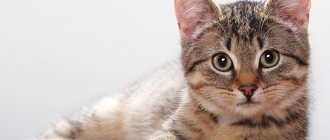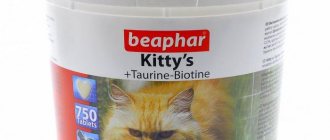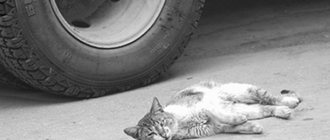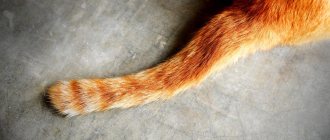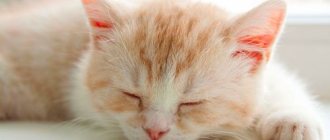Any cat owner should know how to behave in an unusual situation, which includes helping sick or injured pets. And the first thing any owner should understand is that an animal that is sick or injured due to some other reason should be approached very carefully and slowly.
Even if a cat has been living in your home for a long time and has never shown any signs of aggression, it may well do so while in a state of shock, panic, or pain. Please remember that cat bites are quite painful and can be very dangerous. Once you receive them, you certainly won’t help your pet. Therefore, first you should observe the animal’s facial expressions, its body position, fur, tail, ears, eyes and listen to the sounds it makes.
First aid for a cat.
If the animal does not show any signs of aggression, you can slowly approach it. When approaching a cat, you should definitely let your palms smell, especially the backs of them. At the same time, you cannot pull them sharply and quickly. In general, when communicating with an unhealthy animal, you should avoid any sharp or sudden actions. The cat must be able to see what its owner is doing. At the same time, you need to talk to her in a gentle tone, avoiding eye contact, which a sick pet can regard as a threat.
If you are not ready to help your cat yourself, then consult a doctor.
It’s worth stopping at this point and taking a little look at the basic provisions of the cat’s “language.” This, of course, is not about verbal symbols, but about body language.
Warning Signs in Cats:
- The cat presses its body to the ground.
- The ears are pressed back towards the head.
- The cat may hiss or even sputter.
- The pupils are greatly constricted. If the cat is too frightened, the pupils may, on the contrary, dilate.
- The cat raises its tail or arches its back.
- Fur raised on end on the back.
To prevent your cat from biting you, use a collar.
General information about first aid
First aid is the urgent implementation of one or more medical actions necessary in emergency situations. They are undertaken for injured and sick cats immediately on the spot in case of accidents, before the veterinarian arrives.
Therapeutic actions are aimed at improving well-being, removing pain, relieving symptoms of the disease, preventing additional injuries, and reducing the risk of death.
To organize first aid for a cat after being injured, you will need a first aid kit. Therefore, it should be in every apartment where an animal lives.
How to catch a cat
The first thing anyone who wants to catch a cat should understand is that the animal must know where its owner is, otherwise it may be frightened by his sudden appearance and offer active resistance or even rush to attack.
A suitable means of restraining the cat is a towel or blanket. First, a thick and wide towel should be thrown over the animal's body. In this case, you should stand behind him.
You should make sure where exactly the cat is under the towel and how approximately its body parts are located. This is necessary so as not to place your hands near her mouth, otherwise the cat may cause a wound by biting through the towel.
Now you need to grab the cat by the scruff of the neck directly through the towel. Then she will not have the opportunity to roll over onto her back and take a body position in which she could bite her owner through the fabric.
Having captured and secured the cat, you need to carefully wrap the blanket around the cat, leaving only its head or some other part of the body necessary for medical manipulations free.
Diagnostics
When the first symptoms of poisoning appear, you should contact your veterinarian. The specialist will conduct an initial examination of the animal and prescribe additional research methods.
- A physical examination of the cat may reveal general malaise of the pet, an increase in heart rate and breathing, changes in the oral mucosa, and redness of the conjunctiva of the eyes. Palpation of the anterior abdominal wall in case of food poisoning determines an increase in the size of the abdomen, bloating, and rumbling along the intestines.
- A clinical blood test is prescribed to identify pathological changes. For example, an increase in the level of leukocytes and an acceleration of ESR indicates the presence of an inflammatory process in the body.
- If intoxication is suspected as a result of hemolytic poisons entering the body, a coagulogram is prescribed.
- X-ray of the abdominal organs evaluates the condition of the internal organs. This type of study can reveal the presence of pathological processes in the gastrointestinal tract, heart, lungs, and genitourinary system.
- A study of the stomach contents is carried out to determine the etiological factor of intoxication.
Cat box
Cats love boxes and often hide in them even when there is no need for it. This trait can be used if there is a need to move the pet somewhere or carry out any manipulations with it. It would be most convenient if the cat hid not just in a box, but in a cat carrier with an opening top. Then you won’t need to pull the cat out of the carrier through the door. It will be enough to simply open the top cover of the carrier and then use a towel to secure the cat using the method described above.
No serious or visible injuries
Unless the impact was very strong, it is very likely that the injured cat took cover under nearby cars. He will be very scared and may not know how to deal with the accident. Even indoor cats can run away and be alone.
If you are unsure what to do if a cat is hit by a car, first approach it slowly and carefully, approaching without making sudden movements. When you reach an injured cat, treat him with extreme care. You can use a blanket or towel to wrap it around. This will prevent scratches and allow you to lift it without too much pressure. If you have a cat carrier, use it to move them and get them to the vet.
Even if we do not observe external injuries, a running cat may suffer internal injuries that require veterinary attention. Don't give him any food or water because at the veterinary center they will probably have to treat him.
Gloves
Sick cat.
Sometimes the use of gloves is justified, but it should be remembered that they will not make your hands as sensitive as is sometimes required.
In addition, the disadvantage of most gloves is that the material from which they are usually made is not particularly dense and a cat can easily bite through it. Thick fur mittens might be more suitable in this regard, but in them the sensitivity of the hands will be even lower.
How to carry a sick cat
How to feed your cat medicine.
There are probably no special alternatives to carrying here. This is the most convenient form of transportation. If there is no carrier, then the most suitable means is a box, which should be closed and wrapped with tape so that the animal does not escape and does not fall through from below. In this case, it is necessary to leave a small hole for ventilation, approximately 5x5 cm in size. It would be nice if the cat could see its owner through it. You can also use a towel or blanket, but you should always remain vigilant, since many cats have escaped from such captivity and become irretrievably lost. Carrying a cat simply in your arms is categorically not recommended.
If you find an error, please select a piece of text and press Ctrl+Enter.
Kennel ELITE GARSIA
1. Bleeding and ways to stop it Bleeding is divided into arterial, venous and capillary. Arterial bleeding. Blood flows out in a strong pulsating stream, its color is bright red (scarlet). Venous bleeding. Blood flows out in a stream, but does not pulsate, the color is darker. Capillary bleeding. The blood is dark and is released from the entire surface of the wound in drops or a sluggish stream. To stop bleeding, use: a) a pressure bandage; b) tourniquet; c) pressing the vessel with your fingers; d) ligation of the protruding end of a ruptured vessel. Applying a pressure bandage A pressure bandage is used for capillary and small venous bleeding. A sterile gauze folded several times (you can use a piece of sterile bandage) moistened with hydrogen peroxide is applied to the wound (it not only dissolves dirt, but also serves as an excellent disinfectant and hemostatic agent), a layer of cotton wool is placed on top of it, and the whole thing is tightly bandaged. A bandage is applied to the limbs, bandaging from the bottom up so that each subsequent turn of the bandage extends one third onto the previous turn. The pressure bandage can not be removed for up to 1.5-2 days. An ice pack (or a bag of frozen vegetables) can be placed over the bandage to reduce blood flow to the wounded area. Application of a tourniquet A tourniquet is applied for severe venous and arterial bleeding on the limbs and tail. A piece of thin rubber hose, a rubber or regular bandage, braid, a handkerchief, etc. are used as a tourniquet. Remember that the tourniquet is always applied above the bleeding site. The tension of the tourniquet should be sufficient to stop the bleeding, but not excessively strong so as not to cause pain. After applying the tourniquet, apply a pressure bandage to the wound. In the warm season, the tourniquet is left for 1.5 hours, and in winter for no more than 1 hour, so as not to cause tissue necrosis. If there is a need to hold the tourniquet longer than the specified time, then every 40 minutes it is loosened for 3-4 minutes, after first pressing the bleeding vessel with your fingers. If large vessels, such as the femoral artery, are damaged, the vessels should be pressed firmly against the underlying bone with your fingers before applying a tourniquet and bandage. After applying the tourniquet and bandage, the cat should be given warm, lightly salted water, sweet tea or coffee. It should be remembered that tourniquets are dangerous: sometimes they can do more harm than good. If the tourniquet is applied incorrectly, the nerve trunks may be pulled, which can lead to tissue necrosis and paralysis of the limbs. But, on the other hand, the cat may die from blood loss from a ruptured vessel. With small venous and capillary bleeding, a blood clot forms and the wound becomes clogged. In such cases, it is advisable to use pressure instead of a tourniquet to stop bleeding. Use a tourniquet only if the bleeding is very severe and you cannot stop it with other means. As a rule, this is arterial bleeding (see above). To properly apply a tourniquet, wrap a piece of rubber or other available material above the wound and tie it tightly into a knot, then insert a ballpoint pen, pencil, or other suitable object under the knot and twist it tightly until the bleeding stops. Intestinal bleeding Ingestion of sharp foreign objects, as well as some intestinal diseases, may be accompanied by intestinal bleeding. Minor bleeding may be indicated by tarry feces. If there is heavy bleeding, the cat defecates frequently - the stool is dark in color. In such cases, the cat must be kept alone. You cannot feed and water the animal, give an enema or give a laxative! Apply a cold compress, such as a bag of frozen vegetables, to the abdomen and rump area, and then take your cat to the veterinarian for a thorough examination. Pulmonary hemorrhage When hit tangentially by a moving vehicle (car, motorcycle, bicycle), falling from a great height, as well as with some chronic diseases, cats may experience bleeding from the mouth and nose, sometimes along with a bloody cough. The cat must be kept at rest, given a medicine that stops the cough (for example, bromhexine or libexin), and then urgently taken to a veterinarian. You can only drink cold water. Applying a splint or splint A splint is usually applied when a limb is broken. It is almost impossible to successfully splint a restless cat. The cat twitches, trying to throw off the interfering object, and this can lead to further injury to the broken limb. To limit the cat’s mobility, pull a fixing “tights” over it, which can be used as old tights, and wrap it around the entire body, as well as the area of the injury. For this purpose, the bottom part of the tights is cut off, after which they can be easily pulled over the animal’s body. In case of a fracture of the front or hind limbs, splints should be applied. Splinting the forelimb Having tied the ends of the tights around the cat’s body, cut a hole in the right place and carefully insert the injured limb into it. As a splint, you can use a straight stick, a ruler, or at least a pencil, which must be wrapped in a bandage so as not to damage the soft tissue. The splint is tightly bandaged with available material: a tie, a scarf, a belt, a rope. It is best to use an elastic bandage for this purpose. After providing first aid, take the cat to the veterinary hospital. Splinting the hind limb Damage to the hind limb is easily diagnosed - it “hangs”. Possible hematoma formation. The hind limb is immobilized in exactly the same way as the forelimb. Just remember that in case of fractures of the femur, one splint should be applied on the inner, and the second on the outer surface of the hind limb. After providing first aid, take the cat to a veterinary hospital. If the fracture is open and the bone is visible, first apply a sterile cloth to the wound, and only then apply a splint. Do not use any ointments or creams when applying the bandage. Remember that any injury can result in shock, which is very life-threatening. To relieve pain and relieve traumatic shock, inject the cat with Traumeel or Baralgin. 2. Body temperature measurement The cat's body temperature is measured with a veterinary or medical thermometer in the rectum. Considering the importance of this indicator for a veterinarian, try to accustom your cat to this not very pleasant procedure from a very early age. Shake the pre-washed and disinfected thermometer, make sure that the mercury has dropped to the lower level, lubricate the thermometer with Vaseline or any cosmetic cream, then, carefully rotating, carefully insert it into the rectum to a depth of about 1-1.5 cm. The cat should be supported while doing this. under the stomach so that she does not sit down, otherwise the thermometer may break. The thermometer is held for 4-5 minutes. After each use, the thermometer must be cleaned of feces, washed with warm water and soap and disinfected. Nowadays, electronic thermometers are also sold that measure temperature faster, and upon receipt of the result, they themselves notify about this by sounding a sound signal. 3. Taking medications Few animals take medication voluntarily, and cats are certainly no exception. Try to be patient, and it is better to try to accustom your pet to this procedure while she is still young. How to give medications orally As a rule, this method of administering medications is used by the animal owners themselves, on the instructions of veterinarians. Remember, however, that cats are capricious and are unlikely to voluntarily agree to take medications - so try to accustom them to this procedure from an early age. Don’t forget to encourage your cat with kind words and pet it after giving the medicine. There are, however, medications that cannot be given with food. On the other hand, some particularly irritable and capricious cats find it difficult to give medicine by mouth - in such cases, consult a veterinarian. Solid medications (pills, tablets, dragees, capsules) All of these medications can be given to your cat directly with his favorite treat (for example, meat). If you need to give the medicine separately, first talk kindly to the cat, calm it down, then wrap it in a towel so that it does not scratch or fix it with a “senior’s grip”, then, holding the upper jaw with one hand, throw its head back with its nose up, lightly but firmly squeeze ear with two fingers - at the same time the cat will open its mouth slightly - and place the tablet or pill, trying to get it to the root of the tongue. Immediately close the cat's mouth and stroke her neck towards the esophagus for 2-3 minutes until she makes a swallowing movement. Keep your cat's head elevated while doing this to reduce the risk of spitting out the medication. You can also use a douche or syringe without a needle to pour clean water into your cat's cheek to encourage swallowing. Then open your cat's mouth to make sure she has swallowed the medicine. If everything is fine, reward the cat. If not, repeat the procedure. If the tablets are greased with butter or dipped in vegetable oil, it will be easier for the cat to swallow them. You can also place the tablet in a small piece of meat. If the tablet has no taste, it can be crushed and added to food. However, it should be borne in mind that some medications are incompatible with certain types of food, so before adding medication to food or crushing tablets, you should consult your veterinarian. Bulk medicines (powders) Repeat the same steps as in the first case, with the only difference that the powder should first be poured onto the tongue, and then give the cat water. In addition, the powders can be first mixed with water and shaken, or mixed with butter and honey, and spread this mixture on the tongue, lips or teeth. Liquid medicines (solutions, tinctures, decoctions) Hold the upper jaw in the same way as in the previous cases, but try to keep the cat's head in a horizontal position. Then, holding the jaw with one hand, pull back the cheek with the other and pour the medicine from the syringe into the “bag” formed by pulling back the corner of the mouth at the point where the upper and lower jaws meet. Close the mouth and stroke the neck towards the esophagus until the cat swallows the medicine. Encourage her. Liquid medications can also be given by mixing them with your cat's favorite food. To give your cat the mixture, do not tilt the animal's head back - just drop the mixture onto the tongue. Don't forget to reward the animal. The potion and other liquid medicine can also be drawn into a syringe without a needle and injected into the corner of the cat's mouth, pulling back the fold of skin of the cheek. Sugar cubes The simplest and most convenient form of giving medications, the pioneer and leader of which is (“CEVA Sante Animale”, formerly “Sanofi”), which has been present on the Russian market for about 10 years. The drugs from this company (Pillcan, Polyvercan, Diarkan, Execan, etc.) have gained wide popularity not only among cat owners, but also among veterinarians. Thanks to the original release form in the form of sugar cubes, they are easy to use. Sugar cubes taste good and are eaten with pleasure by animals. The cube can also be dissolved in a small amount of drinking water or given in crushed form with food. And no injections or tasteless pills! In this way you can protect your pet from unnecessary stress. 4. How to use eye medications Eye medications are divided into drops and ointments. The main thing when using them is to make sure that they go to the right place. The cat, both before and during the procedure, should be treated as kindly as possible and spoken to in a calm, reassuring voice. To apply eye drops, first wash the dropper and your hands. Then, using a cotton swab dipped in warm water, remove all traces of pus and other discharge from the eye. Then close the upper eyelid with your finger, gently pull back the lower eyelid, drop one drop of the drug (if you drip more, the medicine may leak out) into the fold of the mucous membrane closer to the inner corner of the eye and release the eyelid. Lightly rub the eyelid over the eyeball to distribute the medication more evenly. Then, if necessary, repeat the procedure. When finished, reward your cat and give her a treat. Make sure that the instilled medicine is not too cold - if it is taken from the refrigerator, you should warm it up for a while before using it, at least holding it in your fist. The same applies to ear medications. To lubricate the eye with eye ointment, repeat the same procedure, carefully placing the ointment between the eyelid and the eyeball in the inner corner of the eye, then release the lower eyelid, close both eyelids of the cat and make light massaging movements. This procedure helps to distribute the ointment evenly. If the ointment is not produced in a special tube from which it can be easily and conveniently squeezed into the desired place, then use a glass spatula, which should be thoroughly washed beforehand. Make sure that neither the pipette nor the tube of ointment comes into direct contact with the surface of the eyeball. 5. How to administer medications rectally Some medications are effective when administered directly into the rectum, where they are quickly absorbed and enter the portal vein system. Introducing them to a cat is not at all difficult. Usually, medications are administered rectally in the form of suppositories or microenemas. First of all, sit the cat on your lap. If you are using a candle, first lift the cat's tail with one hand, quickly insert it into the anus with the other, push it deeper with your finger, and then, to avoid pushing it out, press the tail for a minute. When using a microenema, for better absorption of the solution, you should also press the tail for one or two minutes after squeezing. The optimal temperature of the injected liquid is 30-35 ° C, and the total volume should not exceed 20 ml - this promotes rapid absorption. At the end of the procedure, keep the cat on your lap for another five minutes so that it cannot remove the candle. 6. How to give injections Anyone can learn how to give injections correctly; believe me, it’s not difficult at all. It's best to learn these skills as early as possible, since the need for this type of help may arise unexpectedly. Most often, the cat is given saline solution, glucose, antiviral drugs or, for example, insulin injections to treat diabetes mellitus. Your veterinarian may also prescribe injections to treat your cat for anaphylactic shock caused by wasp or other insect stings. In fact, giving injections is very simple - usually much easier than giving a wayward cat medicine by mouth. It is not necessary to disinfect the injection site, since the skin of cats itself has bactericidal properties. If such a desire arises, then you can use 5% iodine or 5% alcohol tincture of propolis. For injection, you must also use sterile syringes and needles. Remember that the cat may twitch at the time of the injection, so fix the syringe on the area where you insert the needle. Draw the medicine into the syringe, then, releasing the air bubbles from the syringe and waiting until they all rise up, squeeze one drop of liquid from the needle. While talking affectionately to the cat, grab the fold of skin on the back at the withers or between the shoulder blades (this place has reduced sensitivity). For intradermal injection, insert the needle into the thickness of the skin fold. For a subcutaneous injection, insert the needle deep under the base of the skin fold towards the armpit (2-3 cm) and squeeze out the contents of the syringe. The medicine after such an injection is absorbed rather slowly, since the blood vessels that penetrate the network of subcutaneous tissue are very small and branched. With an intramuscular injection, a needle is injected into the back muscle groups of the thigh or shoulder, to a depth of 2-3 cm. With this method of injection, medications are absorbed quite quickly, since the muscle tissue is rich in larger blood vessels. However, be sure to restrain your cat before the procedure. Upon completion of the procedure, praise the animal and give a treat. Remember that the method of administration of the drug must be determined by a veterinarian. It is better not to do intravenous injections yourself! 7. How to give a cleansing enema Sometimes, for example, with constipation or other pathological conditions, cats need to be given cleansing enemas. To do this, it is recommended to prepare a decoction of chamomile flowers or use salted water (1 teaspoon per glass of water) at a temperature of 25-30 degrees. Place the cat in a basin or bathtub, or fix it in a lying position (on its left side), draw a solution at room temperature into a syringe, lubricate its tip with Vaseline, lift the cat’s tail and carefully, slowly, with rotational movements, insert the tip of the syringe into the anus to a depth up to 2 cm. Gradually squeeze out the contents. If the enema is nutritious, immediately after removing the tip of the syringe from the rectum, you should press the cat’s tail to the anus, preventing the fluid from flowing out, and hold for 15-20 minutes. After squeezing out the contents of the enema, wait for a bowel movement to take place. 8. How to induce vomiting Having secured the cat, or holding it with the “elder’s grip,” open the cat’s mouth and pour in a supersaturated solution of table salt (a quarter of a teaspoon dissolved in 1 teaspoon of water)—do not lift the animal’s head. Severe irritation of the taste buds on the tongue will cause vomiting. A similar effect is achieved by 3% hydrogen peroxide (2-3 teaspoons, 3 times over 30 minutes). You can use another method, but it is more labor-intensive: you need to forcefully pour water into the cat until vomiting occurs. This may require from 0.05 to 0.25 liters of water, depending on the size of the animal. 9. How to weigh a cat Knowing how much your cat weighs is not just out of curiosity: many veterinary medications are dosed per 1 kg of body weight. The simplest and most accessible way to weigh is to pick up the cat and first weigh yourself with it, and then without it. By subtracting the second from the first readings, you will get the weight of your pet. Remember: to find out the exact weight of a cat, you should weigh it on an empty stomach, after defecation and emptying the bladder.Source - *Veterinary reference book - traditional and non-traditional methods of treatment*
